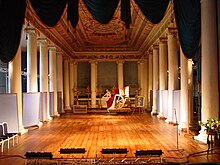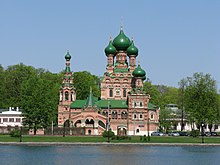
Praskovia Ivanovna Kovalyova-Zhemchugova was a Russian serf actress and soprano opera singer.

Kuskovo was the summer country house and estate of the Sheremetev family. Built in the mid-18th century, it was originally situated several miles to the east of Moscow but now is part of the East District of the city. It was one of the first great summer country estates of the Russian nobility, and one of the few near Moscow still preserved. Today the estate is the home of the Russian State Museum of Ceramics, and the park is a favourite place of recreation for Muscovites.
Argunov - family of artists and architects, serfs of counts Sheremetev. They worked in Moscow and in Sheremetev's mansions, and also in St.Petersburg.

Nevsky Prospect is a main street located in the federal city of St. Petersburg in Russia. Its name comes from the Alexander Nevsky Lavra, the monastery which stands at the eastern end of the street, and which commemorates the Russian hero Prince Saint Alexander Nevsky (1221–1263). Following his founding of Saint Petersburg in 1703, Tsar Peter I planned the course of the street as the beginning of the road to Novgorod and Moscow. The avenue runs from the Admiralty in the west to the Moscow Railway Station and, after veering slightly southwards at Vosstaniya Square, to the Alexander Nevsky Lavra.

Vasily Ivanovich Bazhenov was a Russian neoclassical architect, graphic artist, architectural theorist and educator. Bazhenov and his associates Matvey Kazakov and Ivan Starov were the leading local architects of the Russian Enlightenment, a period dominated by foreign architects. According to Dmitry Shvidkovsky, in the 1770s Bazhenov became the first Russian architect to create a national architectural language since the 17th century tradition interrupted by Peter the Great.
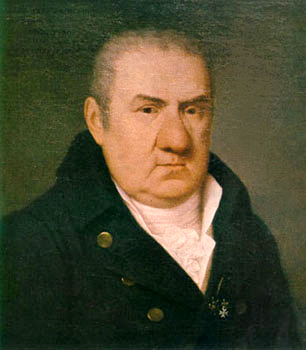
Giacomo Quarenghi was an Italian architect who was the foremost and most prolific practitioner of neoclassical architecture in Imperial Russia, particularly in Saint Petersburg. He brought into vogue an original monumental style, of Palladian inspiration, which was a reference for many architects who worked in Russia as well as the Grand Duchy of Finland.
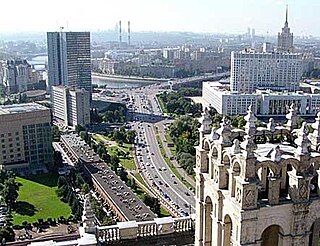
Presnensky District, commonly called Presnya (Пре́сня), is a district of Central Administrative Okrug of the federal city of Moscow, Russia. Population: 123,284 (2010 Census); 116,979 (2002 Census).

Viktor Aleksandrovich Vesnin, was a Russian and Soviet architect. His early works (1909–1915) follow the canon of Neoclassicist Revival; in the 1920s, he and his brothers Leonid (1880–1933) and Alexander (1883–1959) emerged as leaders of Constructivist architecture, the Vesnin brothers. After the crackdown on Constructivism in 1931-32 and until his death, Viktor Vesnin was the highest-ranked architect in Soviet system, heading the Union of Soviet Architects and Academy of Architecture. As a lead architect for heavy construction, he supervised many industrial projects, but his own visionary drafts of this period never materialized.

Matvey Fyodorovich Kazakov was a Russian Neoclassical architect. Kazakov was one of the most influential Muscovite architects during the reign of Catherine II, completing numerous private residences, two royal palaces, two hospitals, Moscow University, and the Kremlin Senate. Most of his works were destroyed by the Fire of 1812; they were later rebuilt with various degrees of alteration.

Maryina Roshcha District is an administrative district (raion), one of the seventeen in North-Eastern Administrative Okrug of the federal city of Moscow, Russia. As of the 2010 Census, the total population of the district was 65,973.

Francesco Camporesi was an Italian architect, painter, engraver and educator who worked in Moscow in 1780s-1820s. Most of his architectural work perished in the Fire of 1812, was severely altered, demolished or otherwise lost.

Izmaylovo Estate was a country residence of the House of Romanov built in the reign of Alexis I of Russia. Originally located 7 kilometres east of Moscow's city limits, it became part of the expanding city in the 20th century. Its territory spanned 10 to 15 square kilometres of the Serebryanka river valley and corresponds, roughly, to present-day Izmaylovo Forest, Terletsky Forest (south-east) and the Cherkizovo market (north-west) territories between the inner ring of the Moscow Railroad and the MKAD beltway.

The Armenian Cemetery of Moscow is an Armenian historical cemetery in Moscow, Russia It is located in the Krasnaya Presnya district, not far from Vagankovo Cemetery. The cemetery was established in 1804 by the initiative of Minas Lazarev, the leader of Moscow’s Armenian community, who also initiated the construction of the Surb Harutyun Armenian church (1808–1815). The Lazarev family crypt is located under the church. The cemetery and the church are under state protection. Among the state-protected monuments are the obelisk on A.A. Loris-Melikov's tomb (1844), Ananov's tombs, khachkar on D.S. Melik-Beglyarov's tomb (1913), and the modernist gravestone for Nikolai Tarasov sculpted by Nikolai Andreev. The Armenian Cemetery is also the resting place for the remains of people who were not of Armenian descent.

Shkolnaya Street is a partially pedestrian street in Tagansky District of Moscow and connects Dobrovolcheskaya Street in the west with Rogozhskaya Zastava Square in the east. The street's heritage area consicts of two-storey 19th century buildings.

The Catherine Palace is a Neoclassical residence of Catherine II of Russia on the bank of the Yauza River in Lefortovo, Moscow. It should not be confused with the much more famous Catherine Palace in Tsarskoye Selo.
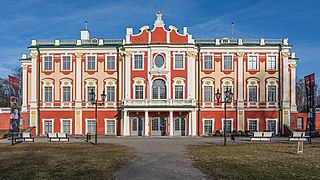
Kadriorg Palace is an 18th-century Petrine Baroque palace in Kadriorg, Tallinn, the capital of Estonia. Both the Estonian and the German names for the palace mean "Catherine's valley". It was built in 1718–1725 to Nicola Michetti's designs by Gaetano Chiaveri and Mikhail Zemtsov. The palace currently houses the Kadriorg Art Museum, a branch of the Art Museum of Estonia, displaying foreign art from the 16th to 20th centuries. The building of the Kumu branch of the museum, showing Estonian art from the 18th century onwards, is located nearby in the Kadriorg Park.

Ivane Bagrationi, was a Georgian royal prince (batonishvili) of the Bagrationi dynasty from the House of Mukhrani. Ivane was a Second-Major of the Russian army although he did not know the Russian language and retired very early. He served at Kizlyar fortress.

Kachanivka Palace is one of the many country estates built by Pyotr Rumyantsev, Catherine II's viceroy of Little Russia. It stands on the bank of the Smosh River near the village of Petrushivka in Pryluky Raion, Chernihiv Oblast, Ukraine. It is perhaps the best known Rumyantsev estate in the region is the Gomel Residence.

The Church of the Nativity of the Theotokos "na Senyakh" is the oldest surviving building in the Moscow Kremlin and the city of Moscow. It has been part of the Grand Kremlin Palace since the mid-19th century. The church cannot be visited. Only the underground floor of the Annunciation Cathedral goes back to the same period of the Middle Ages as this church.

Estates in Russian architecture are typically a settlement complex of residential, household, parks and other buildings, as well as a manicured garden. Estates first appear in the 15th century in the Principality of Moscow and are associated with the estate system.



